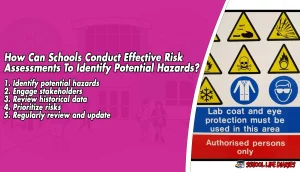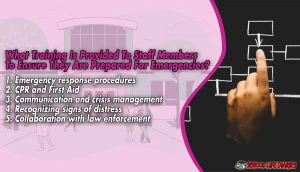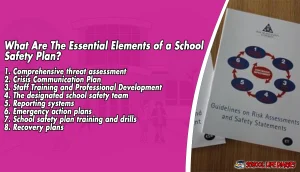In today’s rapidly changing world, ensuring the safety and well-being of students in educational institutions has become a top priority. School safety plan plays a crucial role in creating a secure environment where students can thrive academically and emotionally.
This article will delve into the essential elements of a school safety plan, highlighting their significance and the measures schools can take to implement them effectively.
What Is A School Safety Plan?
A school safety plan is a comprehensive document that outlines strategies, procedures, and protocols to mitigate potential risks and respond effectively to emergencies. It serves as a roadmap for administrators, faculty, and staff members to ensure the safety and security of students on campus.
A well-designed school safety plan covers a range of potential threats, including natural disasters, intruders, medical emergencies, and other hazardous situations.
Why Is The School Safety Plan Important?
School safety plans are of paramount importance for several reasons. Firstly, they provide a systematic approach to safeguarding the well-being of students, staff, and visitors within the school premises. By identifying potential risks and implementing preventive measures, a safety plan helps mitigate the impact of emergencies. Secondly, school safety plans instill confidence and peace of mind among parents and guardians.
Knowing that their children are attending a school with a well-thought-out safety plan in place helps alleviate concerns and fosters trust in the educational institution. Furthermore, a school safety plan demonstrates the commitment of the school administration toward the welfare of its students. It creates a culture of preparedness, empowering both students and staff members to respond effectively in challenging situations.
How Can Schools Conduct Effective Risk Assessments To Identify Potential Hazards?
Conducting effective risk assessments is a crucial step in developing a comprehensive school safety plan. Here are some key considerations for schools to ensure thorough risk assessments:
1. Identify potential hazards:
Schools should conduct a systematic evaluation of their physical infrastructure and surrounding areas to identify potential hazards. This includes assessing the vulnerability of buildings to natural disasters, analyzing the school’s location in relation to high-risk areas, and examining any previous incidents.
2. Engage stakeholders:
Involving relevant stakeholders such as school administrators, faculty members, parents, local law enforcement, and emergency response agencies in the risk assessment process is essential. This collaboration brings diverse perspectives and expertise to the table, ensuring a comprehensive assessment.
3. Review historical data:
Analyzing past incidents and near misses provides valuable insights into the types of risks schools may face. This data helps schools anticipate potential hazards and tailor their safety plans accordingly.
4. Prioritize risks:
Once potential hazards are identified, schools should prioritize them based on their likelihood of occurrence and potential impact. This prioritization helps allocate resources and design targeted mitigation strategies.
5. Regularly review and update:
Risk assessments should be an ongoing process. Schools should regularly review and update their assessments to account for any changes in the school environment or emerging risks. By following these steps, schools can conduct effective risk assessments and develop robust safety plans that address the specific needs of their students and staff.
What Training Is Provided To Staff Members To Ensure They Are Prepared For Emergencies?
Training staff members is a vital aspect of any school safety plan. By providing the necessary training, schools empower their staff to respond effectively in emergencies. Here are some key training components:
1. Emergency response procedures:
Staff members should be trained on emergency response procedures, including evacuation protocols, lockdown procedures, and first aid techniques. Regular drills and simulations should be conducted to reinforce these procedures.
2. CPR and First Aid:
Training staff members in CPR (Cardiopulmonary Resuscitation) and first aid equips them with essential life-saving skills. In emergency situations, quick and appropriate medical interventions can make a significant difference in the outcome.
3. Communication and crisis management:
Effective communication during emergencies is crucial. Staff members should receive training on how to communicate with students, parents, and emergency responders during crisis situations. They should also be trained in crisis management techniques to ensure a coordinated and organized response.
4. Recognizing signs of distress:
Staff members should be trained to identify signs of distress or potential threats among students. This training enables early intervention and support for students who may be struggling emotionally or facing challenges that could impact their well-being.
5. Collaboration with law enforcement:
Collaboration with local law enforcement agencies is essential. Staff members should receive training on how to liaise with law enforcement during emergencies and provide them with accurate and timely information. By investing in comprehensive training programs, schools can ensure their staff members are well-prepared to handle emergencies and contribute to creating a safe and secure learning environment.
What Are The Essential Elements of a School Safety Plan?
A school safety plan should encompass several essential elements to effectively address potential risks and emergencies. Let’s explore these elements in detail:
1. Comprehensive threat assessment:
A comprehensive threat assessment involves identifying potential risks and vulnerabilities specific to the school environment. It includes analyzing physical security measures, assessing the local community’s risks, and considering the school’s geographical location. By conducting a thorough threat assessment, schools can develop targeted strategies to mitigate risks.
2. Crisis Communication Plan:
A crisis communication plan outlines how the school will communicate with students, parents, staff members, and the broader community during emergencies. It includes procedures for notifying stakeholders, sharing accurate information, and ensuring a coordinated response. A well-designed crisis communication plan helps minimize confusion and provides timely updates to ensure the safety of everyone involved.
3. Staff Training and Professional Development:
Continuous training and professional development programs for staff members are essential. These programs should cover emergency response procedures, first aid, crisis management, and other relevant topics. Regular training sessions and drills enable staff members to maintain their skills and stay updated on best practices.
4. The designated school safety team:
Establishing a designated school safety team is crucial for effective emergency response. This team should consist of trained individuals responsible for implementing safety protocols, conducting drills, and coordinating with external agencies. Having a dedicated team ensures that safety measures are consistently enforced and updated.
5. Reporting systems:
Implementing a reporting system allows students, staff, and parents to report potential safety concerns or suspicious activities. This can be in the form of an anonymous reporting mechanism to encourage individuals to come forward without fear of retaliation. Regularly reviewing and acting upon these reports helps address potential threats proactively.
6. Emergency action plans:
Emergency action plans outline specific protocols for various types of emergencies, such as natural disasters, active shooter incidents, or medical emergencies. These plans include evacuation routes, designated assembly areas, and specific roles and responsibilities for staff members. By having well-defined action plans, schools can respond swiftly and effectively to emergencies.
7. School safety plan training and drills:
Regular safety plan training and drills are essential to ensure that students and staff members are familiar with emergency procedures. These drills help build muscle memory, reduce panic during emergencies, and identify areas for improvement. Schools should conduct drills periodically and debrief afterward to assess their effectiveness.
8. Recovery plans:
Recovery plans focus on restoring normalcy after an emergency. They include measures to support students and staff members emotionally, address any physical damage to the school, and restore educational activities. Recovery plans also involve engaging with support services and the community to aid in the healing process.
By incorporating these essential elements into their safety plans, schools can create a comprehensive framework that promotes a secure and nurturing environment for students and staff.
How Are The Specific Needs of Diverse Student Populations Addressed In The School Safety Plan?
School safety plans should take into account the specific needs of diverse student populations to ensure an inclusive and equitable approach. Let’s explore some strategies for addressing these needs:
1. Language accessibility:
Schools should provide translated safety plan materials and ensure that staff members can communicate effectively with students who speak languages other than English. This includes having multilingual staff or interpreters available during emergencies.
2. Disability accommodations:
Schools must consider the needs of students with disabilities when developing safety plans. This includes providing accessible evacuation routes, and specialized equipment, and training staff members on supporting students with disabilities during emergencies.
3. Cultural considerations:
Schools should be sensitive to cultural differences and incorporate cultural competence training into their safety plan. This ensures that responses to emergencies are respectful and inclusive of diverse cultural practices and beliefs.
4. Mental health support:
The safety plan should include provisions for addressing the mental health needs of students. This can involve training staff members in recognizing signs of distress and providing appropriate support or referrals to mental health professionals.
5. Collaboration with families:
Engaging families in the safety planning process is crucial. Schools should actively involve parents and guardians, particularly those from diverse backgrounds, in developing and reviewing safety plans. This collaboration fosters trust and ensures that the unique needs of students are considered. By prioritizing the specific needs of diverse student populations, schools can create safety plans that are inclusive and responsive to the diverse nature of their student body.
Related Article: Inclusive Education For Students With Disabilities
Conclusion:
A school safety plan is an indispensable tool for ensuring the well-being of students and staff members. It encompasses various elements, including risk assessments, crisis communication, staff training, and addressing the needs of diverse student populations.
By implementing these essential elements and investing in better physical security measures, schools can foster a secure and conducive learning environment. Prioritizing safety demonstrates a commitment to student welfare and creates a sense of trust among parents and the broader community. Remember, the safety and security of students should always remain a top priority for educational institutions.








